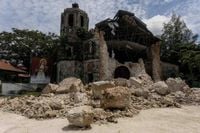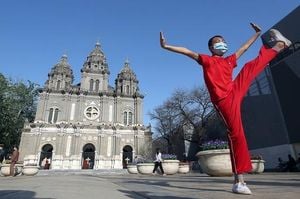In the pre-dawn hours of October 13, 2025, the central Philippine province of Cebu was rattled once again by a powerful aftershock, deepening the anxiety and hardship of a region still reeling from a devastating earthquake just weeks prior. According to the Philippine Institute of Volcanology and Seismology (Phivolcs), the magnitude 5.8 aftershock struck at approximately 1 a.m., its epicenter located some 14 kilometers west of Bogo City—the same area that bore the brunt of the catastrophic 6.9 magnitude earthquake on September 30.
For the people of northern Cebu, the ground has hardly stopped moving. Since the main quake, Phivolcs has recorded a staggering 11,835 aftershocks as of October 13, with 46 of them strong enough to be felt by residents. The relentless tremors have left nerves frayed and communities wary, especially as the aftershocks continue to cause damage and raise questions about the safety of homes and public infrastructure.
The September 30 earthquake was a disaster of historic proportions for Cebu. The official death toll has risen to 75, as confirmed by the Office of Civil Defense and reported by GMA Integrated News. More than 1,500 people were injured, and the number of damaged houses has climbed to over 84,000, with at least 5,587 completely destroyed. The scale of the devastation is hard to overstate: entire neighborhoods were left in ruins, families displaced, and vital infrastructure compromised.
As if the initial shock wasn’t enough, the aftershocks have continued to test the resilience of the region. Monday’s tremor, the strongest since the main event, injured at least 14 people. According to official data cited by The Manila Times, eight were hurt in Bogo City, while six more suffered injuries in the nearby towns of San Remigio and Daanbantayan. Fortunately, all the injured were reported to be in stable condition, but the psychological toll has been significant.
The aftershock also inflicted further damage on already weakened structures. In San Remigio, a road was torn up, while in Bogo, a wall collapsed at a government hospital. Cracks appeared on interior roads in several areas, though, according to Phivolcs director Dr. Teresito Bacolcol, no major vital infrastructure was reported to have sustained new significant damage. Still, the visible scars left by the earthquakes serve as a constant reminder of the region’s vulnerability.
The ongoing threat has forced many families to make difficult choices. With the ground still unsettled, a significant number of residents are opting to stay in tent cities or camp outdoors, too fearful to return to their homes. Dr. Bacolcol emphasized the importance of caution, advising, "If there are visible damages to the structures where they live, they should not go inside." He added, "They have to consult their municipal or city engineers because if it wasn't totally damaged during the main shock, it could be totally damaged during a strong aftershock." (GMA Integrated News)
Authorities have responded with an urgent call to action. The Department of the Interior and Local Government (DILG) has directed all affected local governments to immediately conduct thorough inspections and structural evaluations. According to a DILG advisory, priority should be given to buildings in heavily affected barangays and those with visible cracks, partial collapse, or foundation damage. The directive also instructs local officials to inspect structures affected by ground fissures, sediment venting, and subsidence before allowing anyone to reoccupy them.
"Residential structures must also be properly assessed to determine the extent of damage and ensure the safety of occupants," the DILG statement read. Local governments have also been told to expedite the processing and issuance of permits for repair or reconstruction work, a move intended to speed up the region’s recovery and get families back into safe homes as quickly as possible.
The provincial government has extended the operations of its Emergency Operations Center (EOC) in response to both the continuing aftershocks and the ongoing humanitarian needs. As of October 13, 2025, relief and recovery efforts are ongoing for the more than 540,000 individuals affected by the disaster. Many of these people have lost everything—their homes, their livelihoods, and, in some cases, loved ones.
Financial assistance has begun to flow into the region, offering some hope amid the devastation. Cebu province has received a total of P121 million in cash donations, including P50 million from the Office of the President and contributions from foreign governments. These funds are being used to support relief operations, provide temporary shelter, and begin the long process of rebuilding.
But the challenges are immense. Local governments have requested additional structural engineers and geotechnical experts to help assess building safety and investigate new ground fissures and sinkholes that have appeared as a result of the ongoing seismic activity. The need for expertise is urgent: with so many structures compromised and the earth still shifting, the risk of further collapses remains high.
According to Cebu Daily News, the aftershocks are expected to continue for some time, a reality that complicates recovery efforts and keeps the population on edge. Phivolcs director Dr. Bacolcol explained that aftershocks are a normal part of the earthquake cycle, describing them as "small earthquakes that occur right after the main shock." Yet, for those living through them, there’s nothing small about the fear and disruption they cause.
Amid the chaos, stories of resilience and solidarity have emerged. Community members have come together to support one another, sharing resources and helping to clear debris. Volunteers and government workers labor around the clock, delivering aid, setting up temporary shelters, and conducting safety inspections. The scale of the disaster has tested the limits of local capacity, but it has also revealed the strength of the Cebuano spirit.
Looking ahead, the path to recovery will be long and fraught with uncertainty. The damage to homes—over 84,000 affected, with thousands completely destroyed—means that many families face months or even years of rebuilding. The psychological scars may last even longer, as the memory of the earth’s violent shaking lingers.
Yet, as the region grapples with its losses, there is also a sense of determination. The rapid mobilization of aid, the influx of donations, and the coordinated response from local and national authorities offer a glimmer of hope that Cebu can recover. The lessons learned from this disaster—about preparedness, building safety, and the importance of community—will shape the region’s future resilience.
For now, as aftershocks continue to rumble beneath their feet, the people of Cebu are focused on the immediate tasks: caring for the injured, sheltering the displaced, and beginning the painstaking work of rebuilding their shattered communities. The road ahead may be long, but the resolve of those affected remains unbroken.




